25 Customer Service KPIs You Should Be Tracking in 2022
You can’t improve what you don’t measure. While we all know it’s true, KPIs, metrics, and goals are often hard to measure and keep a track of.
Yet, no customer service team can move forward if they are not aware of the direction they’re heading towards.
Today, we’ll show you 25 customer service KPIs that you should be tracking in the current year.
Each of them touches on different parts of customer service and will allow you to make the changes necessary to provide the service your customers deserve.
Customer Satisfaction Score (CSAT)
Customer satisfaction is the holy grail of customer service KPIs because, in the end, it reflects everything customer service-related.
This is what you’re really optimizing for in all your customer service efforts. It’s quite straightforward but it’s also worth exploring why.
Your internal work, how nice your reps are, how quick they are, how smooth your service is – the average of that will be reflected in the customer satisfaction score, also known as CSAT.
There’s no one way to measure it. The correct way to do it is to pick a scale – numeric, stars, smiley faces, percentage, like/dislike – anything that works for you. Then take the average of that metric and you get a rating of your customer service.
It’s important not to complicate the scale. The surveys you run must be simple, otherwise, your customers will get confused and will pick a “wrong” answer or won’t bother to leave the score at all.
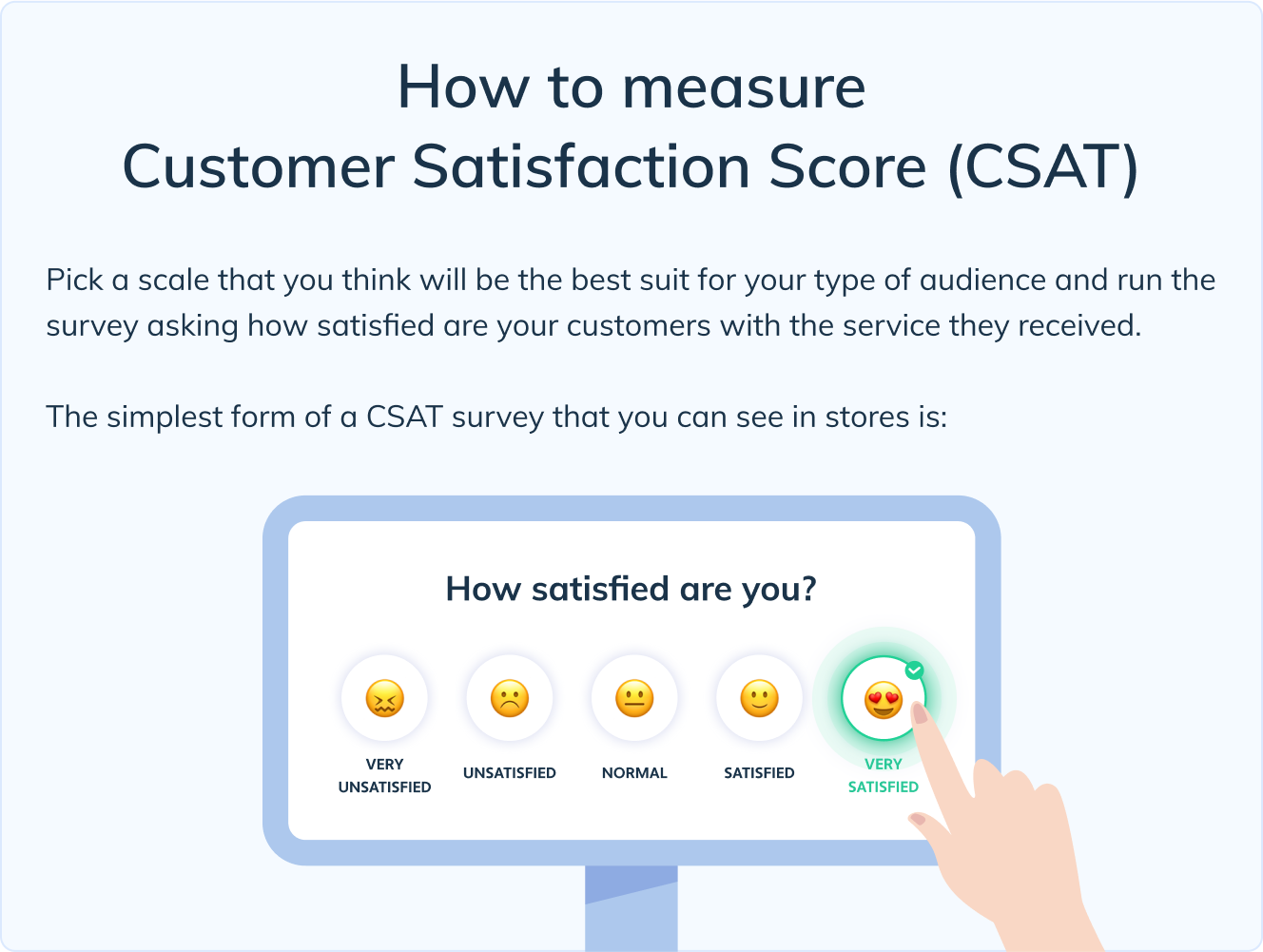
Net Promoter Score (NPS)
The NPS customer service KPI measures how likely your customers are to refer your business to someone else.
It’s a very pragmatic choice, as the person has to think about how your business will depict themselves in the eyes of others. If it’s good then referring to it can only lead to good things like satisfied and grateful friends.
On the other hand, if you prefer something faulty, your friends won’t likely ask you about the recommendation anymore.
Here, the framework is the same as in terms of CSAT. Choose a scale – numeric (0-10) is the most common – and analyze the answers.
In general, only people from the 9-10 range are promoters, the rest are either passive (7-8) or won’t refer you anytime soon (0-6).

First Response Time
One of the customer service principles is speed and that is reflected in the first response time customer service KPI.
Customers prefer or rather require an answer to be quick. In fact, it’s much better to give a simple answer (but any!) and do it quickly rather than delay the answer to provide more details.
This can be solved by automating the customer service process.
For example, if you’re offering customer service via the phone you can use systems such as IVR. Thanks to it, your customers will hear a welcoming message that will guide them through available options to connect with your reps. Then by picking a certain number on a keypad they can choose a reason for their call.
This way they won’t have to wait too long for the first response and you won’t have to redirect the call or put your customers on call.
Try It Yourself
If you want to streamline your customer service, implementing an IVR is the best choice.
You can try IVR in Channels for 7 days free.
No credit card required, no limitations.
Increase your FTR and provide service your customers will enjoy!
When it comes to email, you can send automated messages informing a customer that someone is already investigating their case.
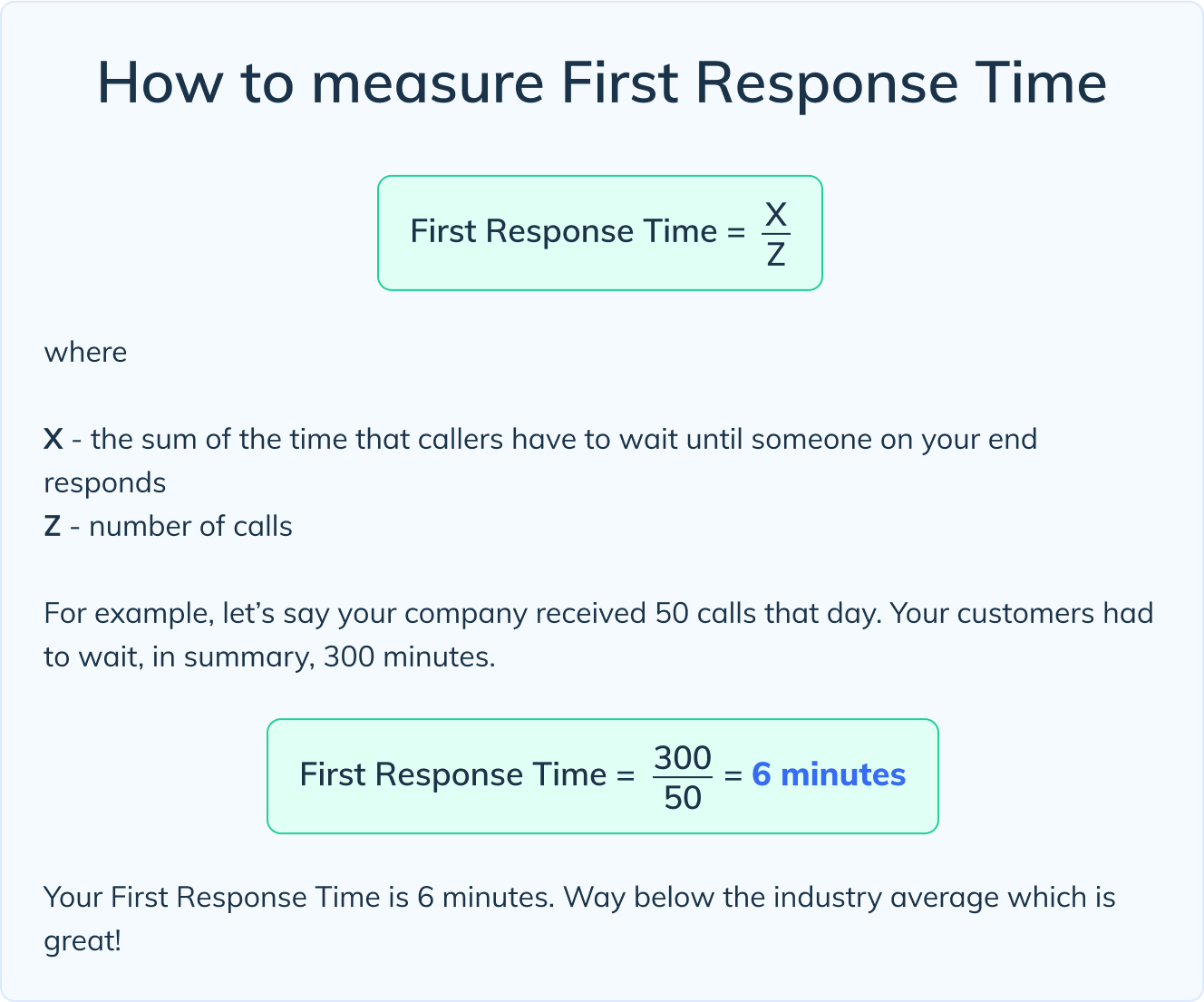
Customer Retention Rate
Customer retention is one of the pillars of customer service KPIs for nowadays businesses. With the growing number of SaaS companies and monthly payments, getting the customer to stay is more important than acquiring one.
In fact, acquiring a new customer costs you around 8 times more than retaining an existing one. Thus, it almost doesn’t matter what’s your business model. You should still care about retention.
Customer retention rate is a KPI that measures how many customers you’re able to retain over a certain period of time. The higher the percentage the healthier your business is.
That’s because the retention rate indicates that your product or service is a long-term investment and that people who try it are satisfied and are not likely to turn into a competition.
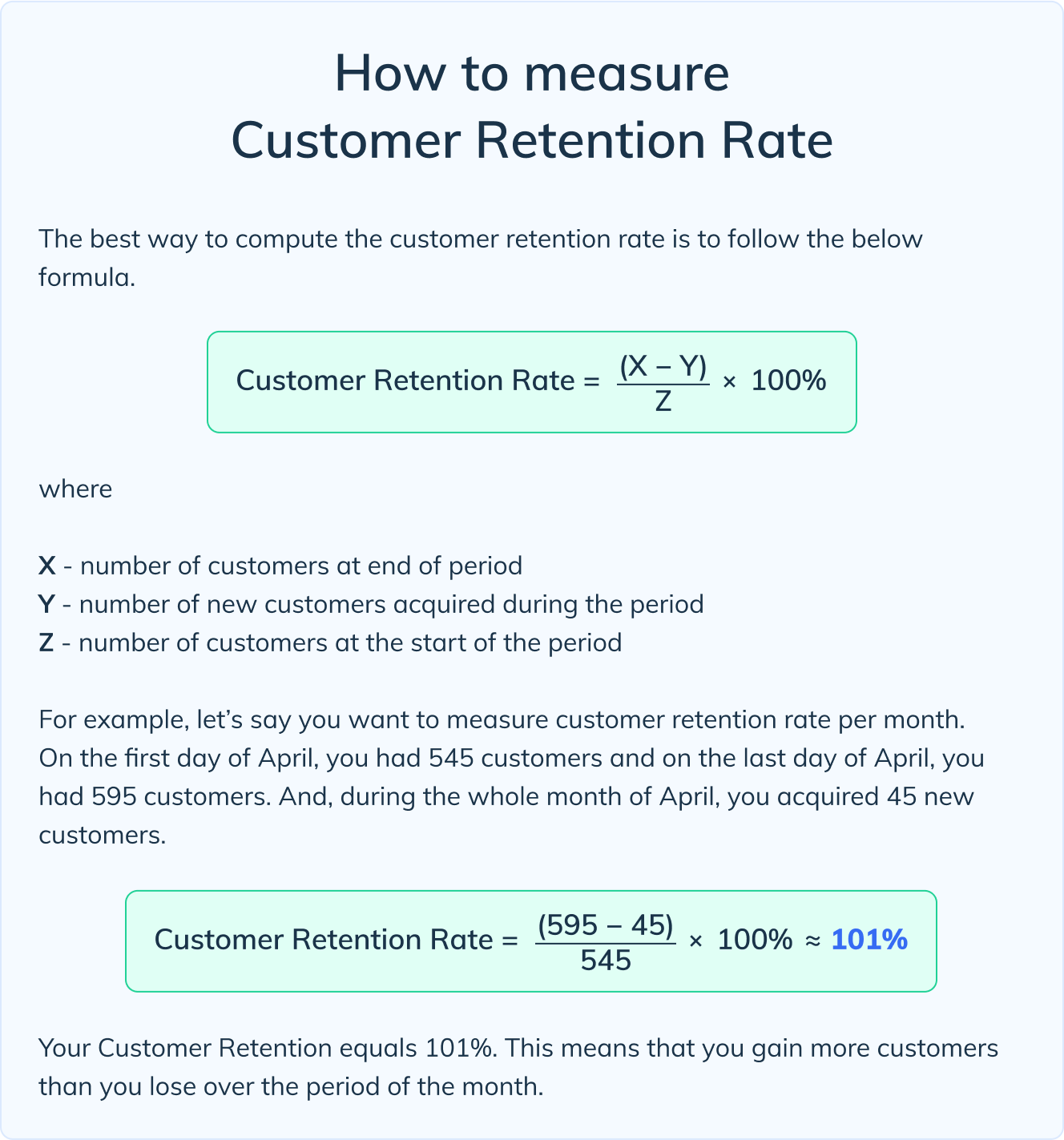
SERVQUAL
SERVQUAL metric is the customer service KPI, which is a combination of service and quality and it opts to measure your customer expectations about your customer service in comparison to how it actually is (how they perceive it).
The way it works is quite straightforward.
You need a questionnaire with “how questions” you’d like to get to know about your service.
The first part of this questionnaire should be about their perception of the provided service. Here, you’re asking your customers “how it is”/”how it was”.
Then, in the second part, you ask “how it should be” which taps into their expectations.
The way you measure the output is by letting the customer choose between the Strongly Disagree and Strongly Agree scale.
After you get the answers, the difference between expectations and reality will reveal the gap (or its lack!) of how your customers would like to be treated and how they’re treated.
SERVQUAL is a great way to find holes in your customer service and to learn about customers’ expectations.
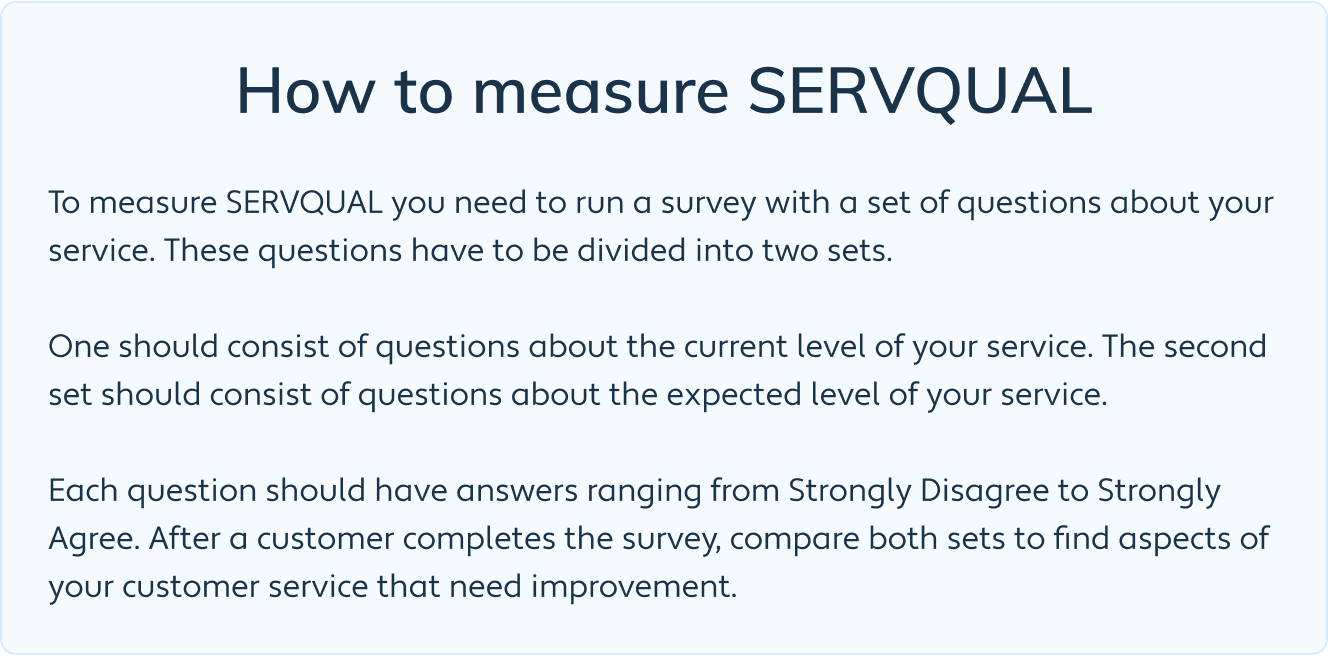
Employee Engagement
This is one of the most important customer service KPIs. Why? Because your service can be only as good as your employees are. There’s no substitute for a knowledgeable and kind representative on the other side of the phone.
And that’s why it’s key to measure your employees’ engagement.
Plus, your team is comprised of many reps who interact with each other and form a collective. If one of them is off it’s likely the rest will follow.
But the question is How do you actually measure employee engagement?
Well, several options are worth trying out.
First is the simplest and all you have to do is ask questions such as “How meaningful is your work?”, “How much do your opinions about work matter to your supervisor?”, “Are you proud to be a member of your team?”.
You can do it via surveys using tools such as SurveyMonkey or Typeform.
The other way to measure employee engagement is to create a set of sub-metrics such as
- Management quality and time investment
- Influence from colleagues
- Relationships
- Work schedule
All these sub-metrics reveal employee engagement and how likely they are to stay at your company. If a person is “lacking” in any of these categories help them improve their work quality.
After all, how well your employees feel is a win-win or lose-lose situation. If they’re engaged they’ll be happy about themselves and their output will be much better. Otherwise, they’ll keep working in a job they hate decreasing their happiness and the quality of their output.
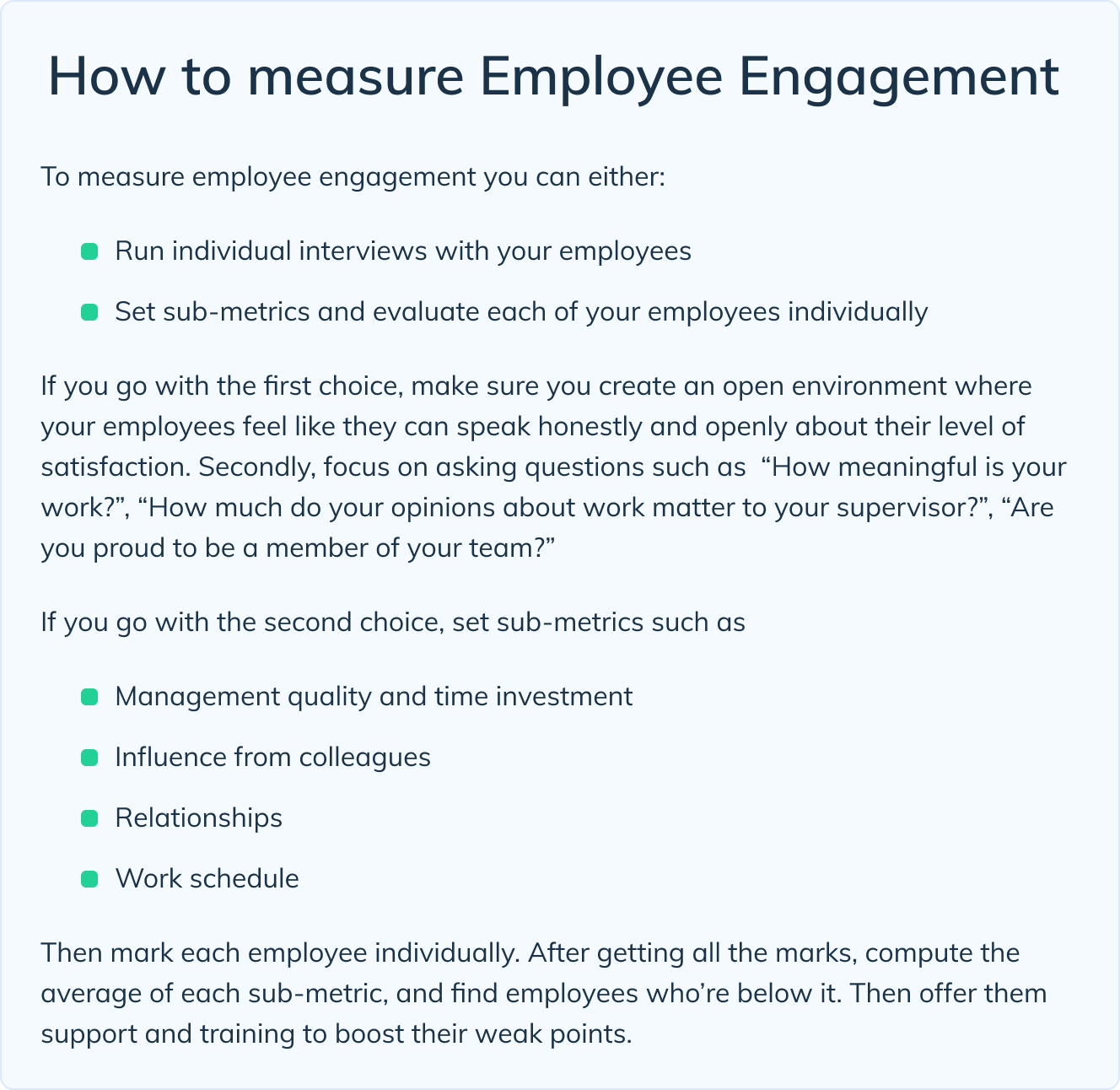
First Call Resolution
As mentioned before, this is the widely demanded customer service KPI. But the speed not only relates to how fast you pick up the phone/respond to an email but also how quickly you solve the issue.
First call resolution is one of the KPIs that depicts just that kind of speed.
It indicates how many problems your agents can solve the first time a customer contacts your company.
If you’re able to solve most of the problems during the first call you’ll be able to take a lot of workload out of your reps’ shoulders. And, most importantly, your customers will be happy that it took you so short to get in touch with your company and solve their problems.
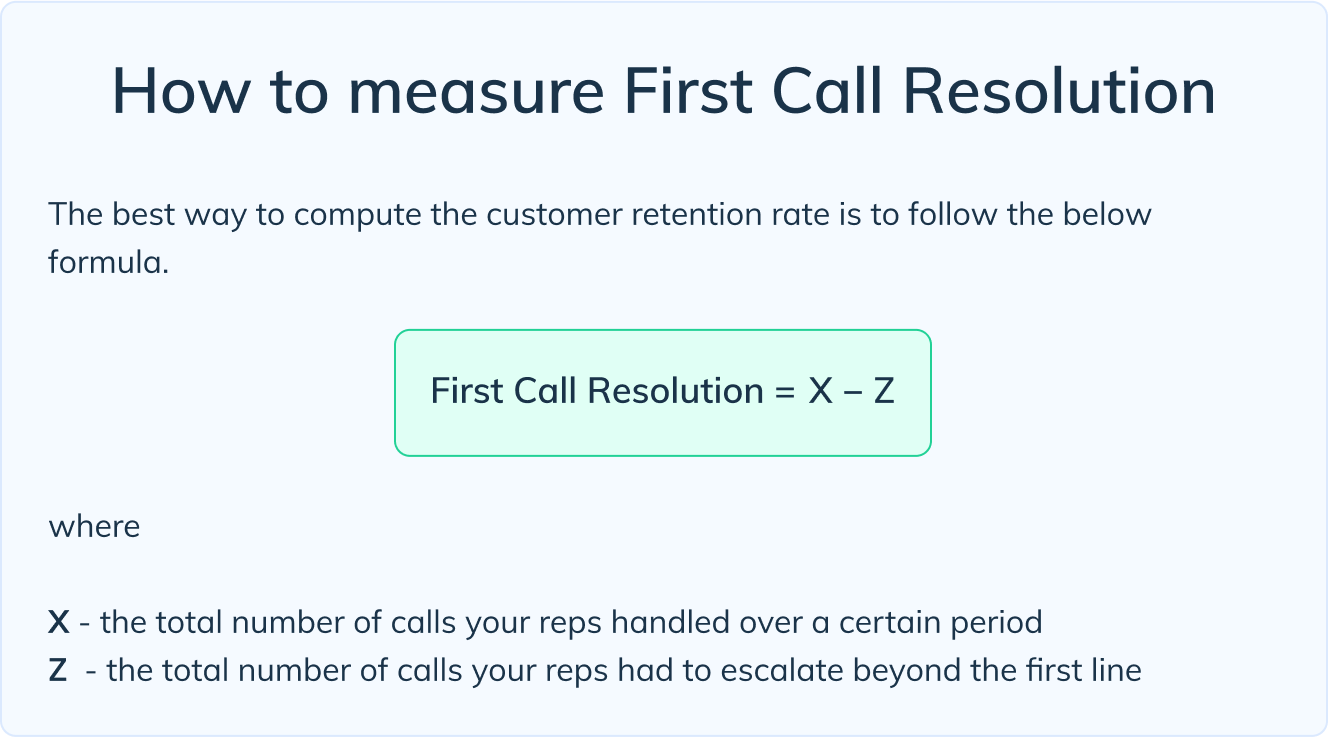
Number of Issues
The volume of requests you get is a very simple KPI to measure but it can change how you perceive your customer service in general.
It influences the number of representatives you need at your company, the tools you should use, techniques you should implement, and more.
It may, in fact, reveal that you don’t need so many resources and you can limit the number of tools you utilize. Plus, it will help you put another customer service KPIs into perspective.

Customer Effort Score (CES)
CES is a customer service KPI that depicts how easy it is for your customers to get used to your product or service.
What does it have to do with the customer service itself?
Well, SaaS businesses often utilize various onboarding techniques and demo sessions to introduce customers to their products. Here, it’s important to help users understand the ins and outs of your offerings so they find the actual value and stick with it.
CES can be measured as a simple 0-10 or 0-100 metric. Simply ask your customers “On a scale of 0-10, how much effort did you put in while using our product/finding what you were looking for?”
The easier it is the more likely your customers will be to stay and your reps will have less work to do (because of fewer contacts with customers).
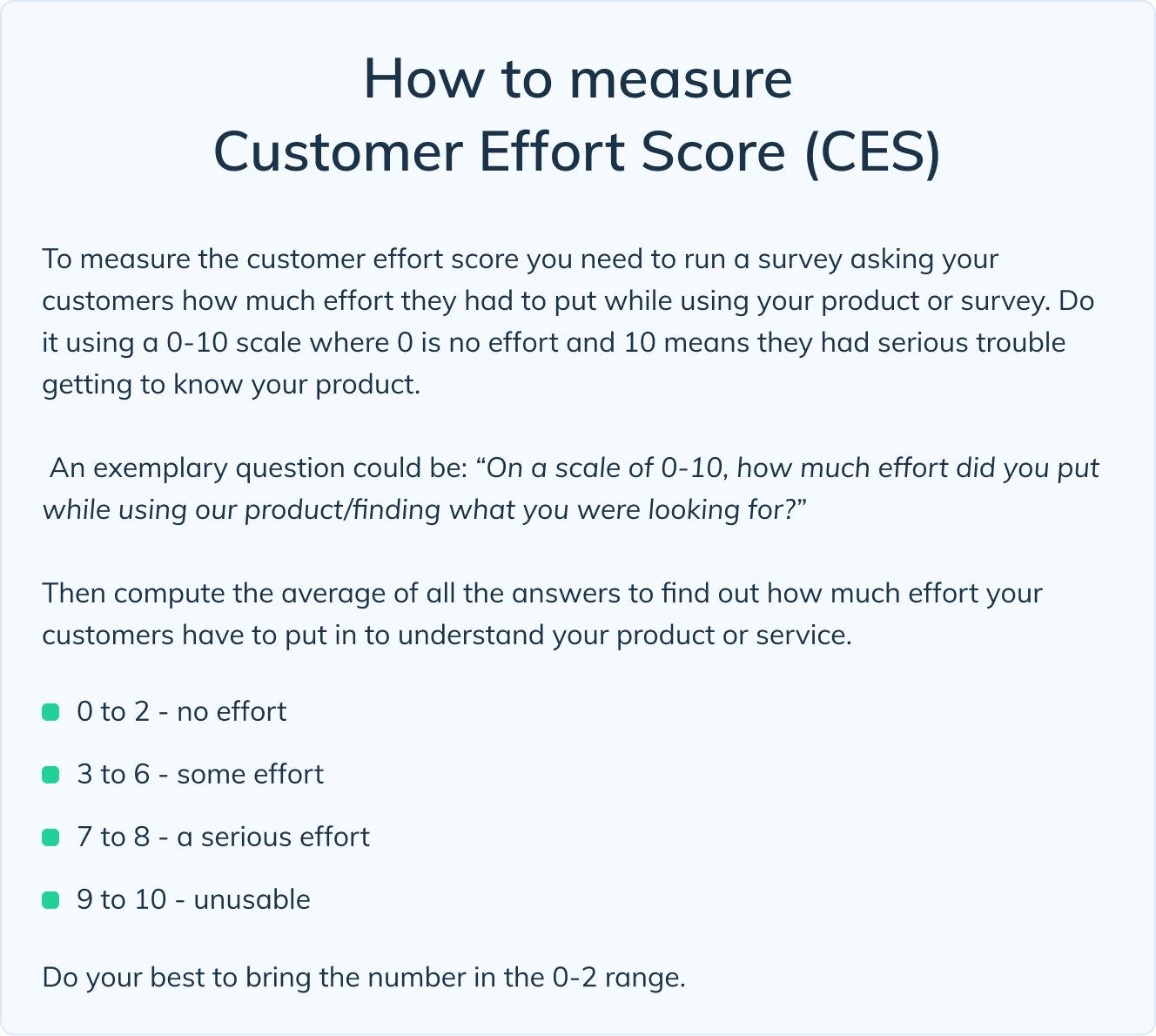
Support costs vs revenue
Support costs vs revenue is an important customer service KPI. Why?
Some people claim that your support center should be a profit center inside your company. The truth is your support center will always create costs instead of generating revenue. And, that’s good.
Keep in mind, that your customer service is a cost-generating machine that’s meant to generate revenue in a non-direct way. Yet, if you try to measure the revenue generated by customer service you’ll create a lot of mess and will discover a ton of vanity metrics that will blur the vision.
By measuring how much you spent on customer service-related resources you can optimize these costs for your overall revenue.
Of course, there’s no one answer to how much you should be spending on customer service. The lesser the better.
The sole purpose of this customer service KPI is to realize what you can optimize and then do it. In the age of evergrowing software stacks, it’s easy to end up with various tools that you rarely or never use.
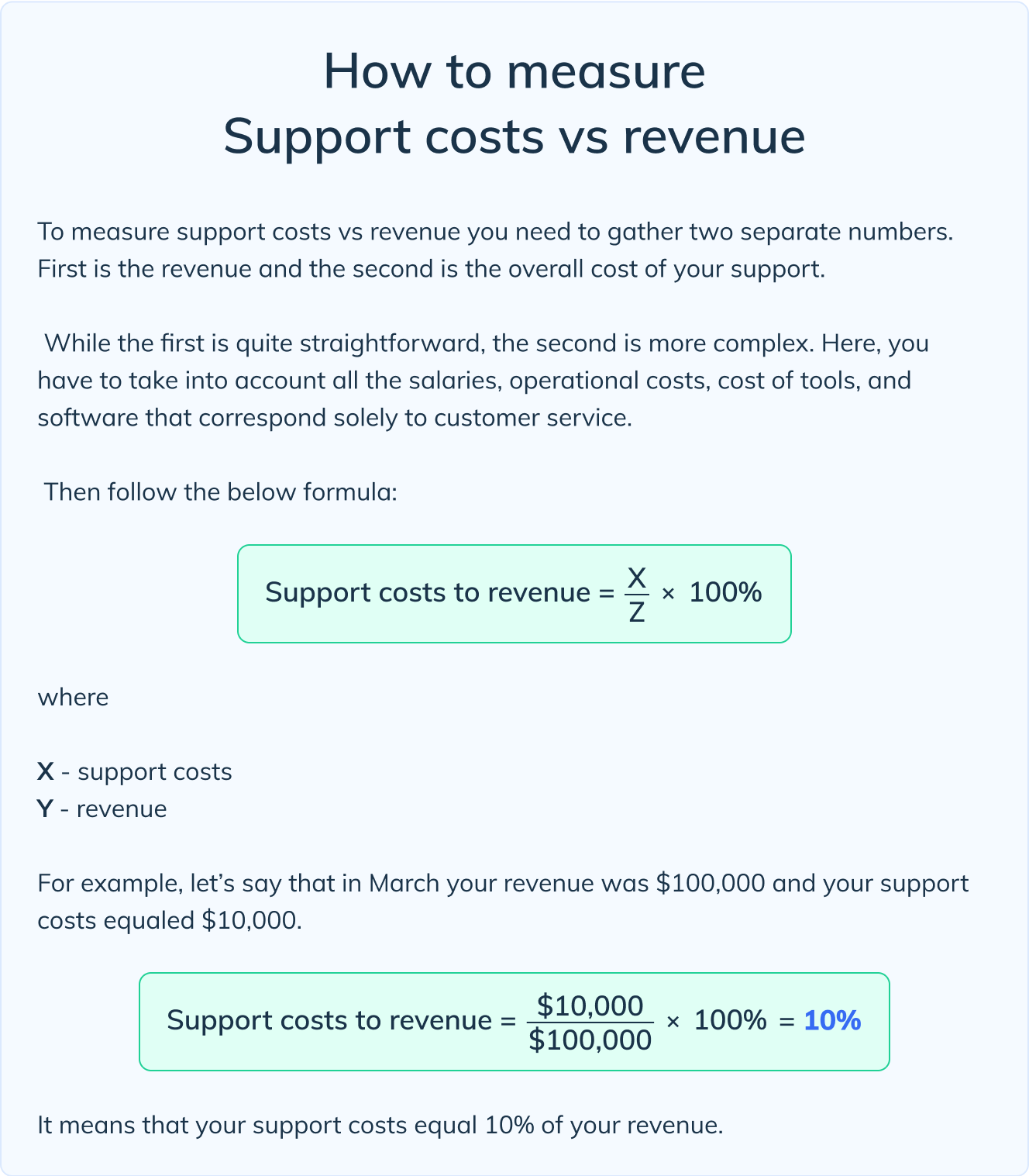
Average resolution time
Earlier on we’ve touched on customer service KPIs such as First Call Resolution which indicates how many cases you’re able to resolve during the first contact with the customer.
Of course, way too many cases will turn out to be too complex to solve right away. Thus, the resolution time will lengthen and your customers will have to wait to get their problems resolved.
Here, it’s crucial to keep this time as short as possible.
Average resolution time indicates how long it takes, on average, to get from the point where your customer informs you about the issue to the point of the resolution.
Again, the shorter the better. Optimizing for speed and accuracy is what customers will appreciate. After all, we all want our problems to be solved as fast as possible with as much accuracy as possible. It can be achieved by leveraging technologies like AIOps and Robotic Data Automation (RDA).
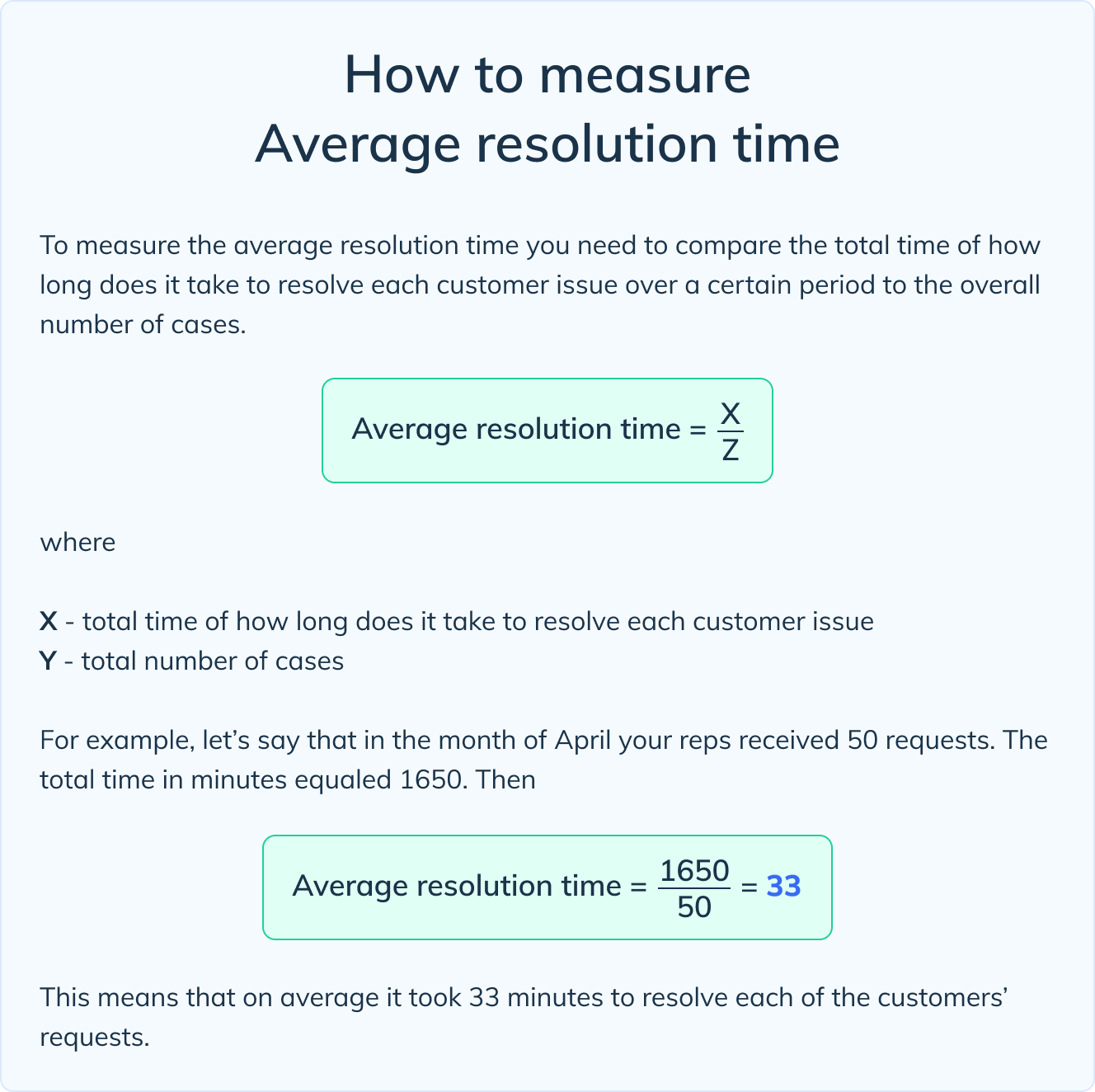
Number of acquired reviews
This customer service KPI is not your usual CSAT or FTR. That’s because it’s much harder to acquire reviews than it is to get someone to complete a one-question survey.
Yet, reviews are probably the best indicator of the quality of your offering and your customer service.
If your reps do an excellent job, your customers will likely mention it in their reviews.
The key is to incorporate reviews acquisition into the process of your customer service. Your reps should actively seek reviews and focus on generating user-generated content.
Only then you can expect this number to grow.
And the best thing is that you can use customer reviews in any way you want! Use it as social proof on your website, on review websites to boost your ratings, or use it as UGC to boost your SEO.
Pick the tactic and the period that you’ll measure the number of reviews over. Then analyze which methods yield the best results and double down on that.
Having a certain goal will also help you hit the number of reviews that you’d like to acquire.
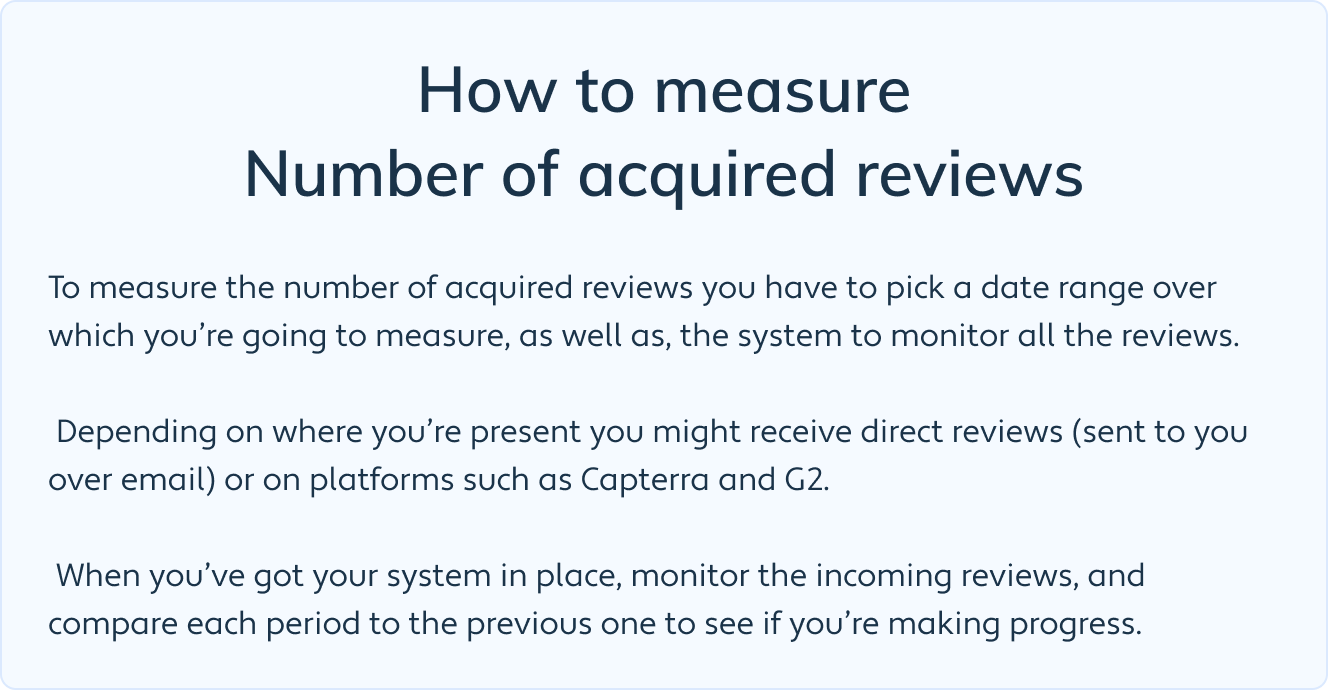
Number of knowledgebase articles
Nowadays, customer service KPI can’t be limited to just one channel. Customers expect that they’ll be able to reach your business via a set of resources rather than one medium.
One of such resources is a knowledge base.
It’s a self-serve type of customer service resource and customers who like to solve issues on their own, highly appreciate robust knowledgebases.
That’s why if you have one (if you don’t, set up one asap) it’d be wise to commit some time for its development. The more articles you have in your knowledge base the more issues can be solved without your representatives being involved.
Set a certain goal like 3 articles a week and stick to it. Then measure each week or month compared to the prior period.
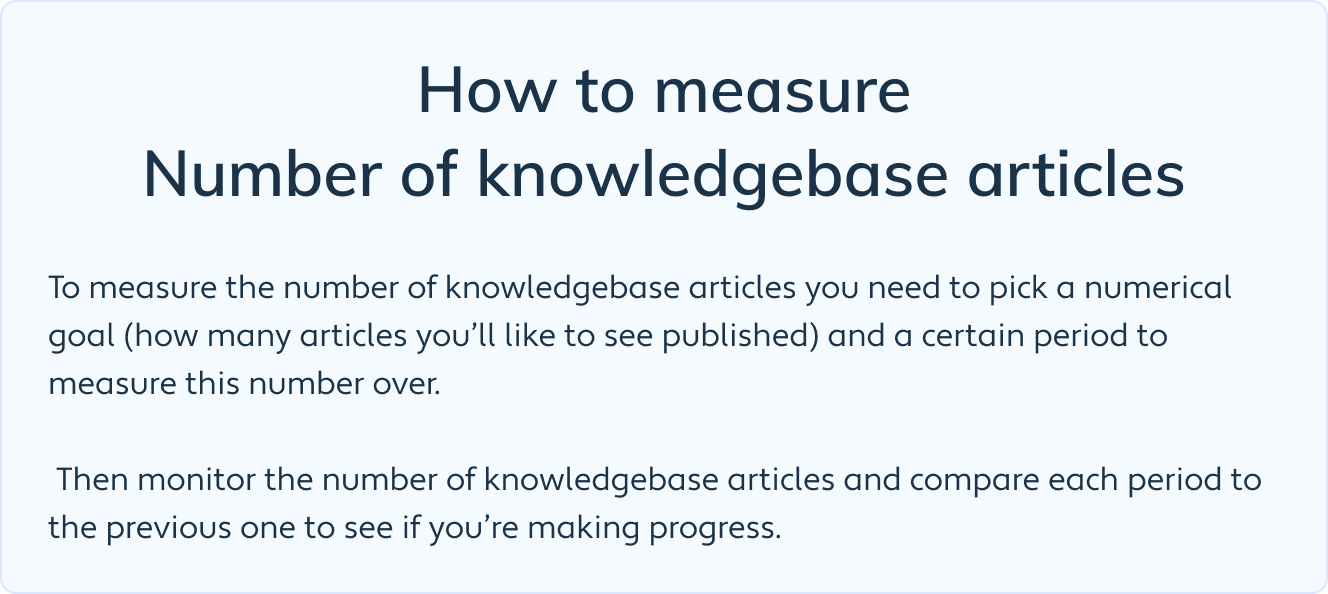
Number of demos
One of the best ways to introduce a lead to your product or service is to conduct a demo session.
Customers expect robust software that will cover a lot of features and will be an answer to all of their problems. Yet, the more robust these tools get the harder it becomes to navigate around and to figure out what is where on your own.
That’s why demo sessions are key to getting new customers started.
While customer service reps don’t find demo sessions amusing – after all, you have to do the same presentation over and over – it’s crucial to understand their importance.
Set a certain goal and do your best to introduce your product with a hands-on demonstration as often as possible.
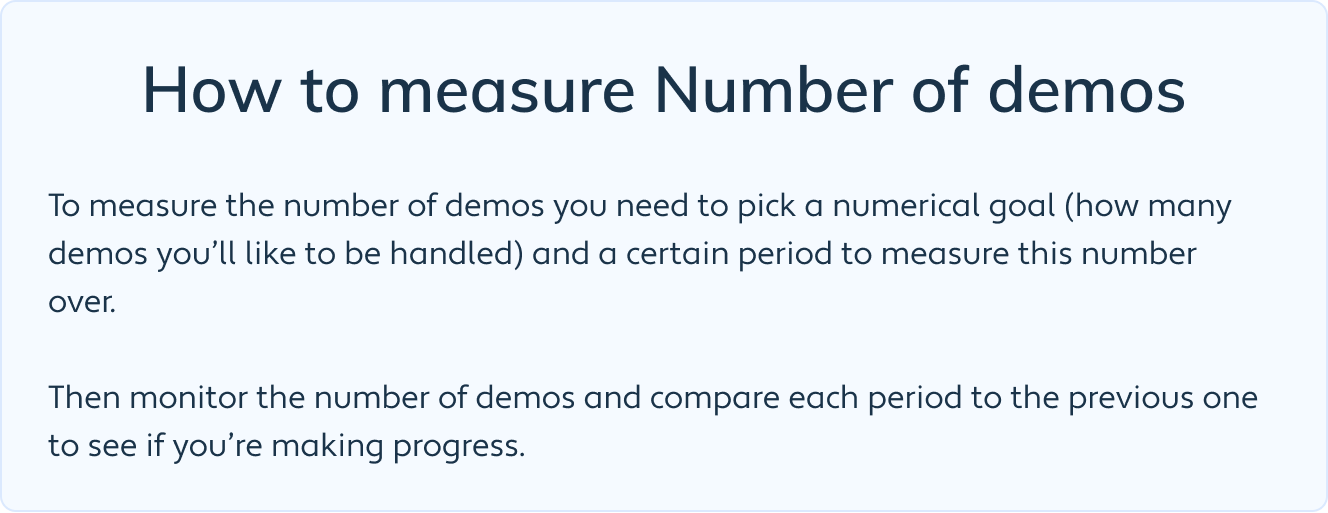
Number of upsells and cross-sells
At first glance, you might wonder why upsells and cross-sells should be considered as customer service KPIs.
Well, of course, selling is never the priority of the customer service department, and if so, not directly. But, sometimes the opportunity is just there and customer service reps who know the best which pricing plan to choose depending on someone’s needs can successfully offer upsells and cross-sells.
While it shouldn’t be one of the main customer services KPIs that you use to measure the effectiveness of your service you may treat it as an add-on. Similarly to the number of demos and knowledgebase articles.
None of them is essential, but they could be a dealbreaker for your customer service and your company as a whole.
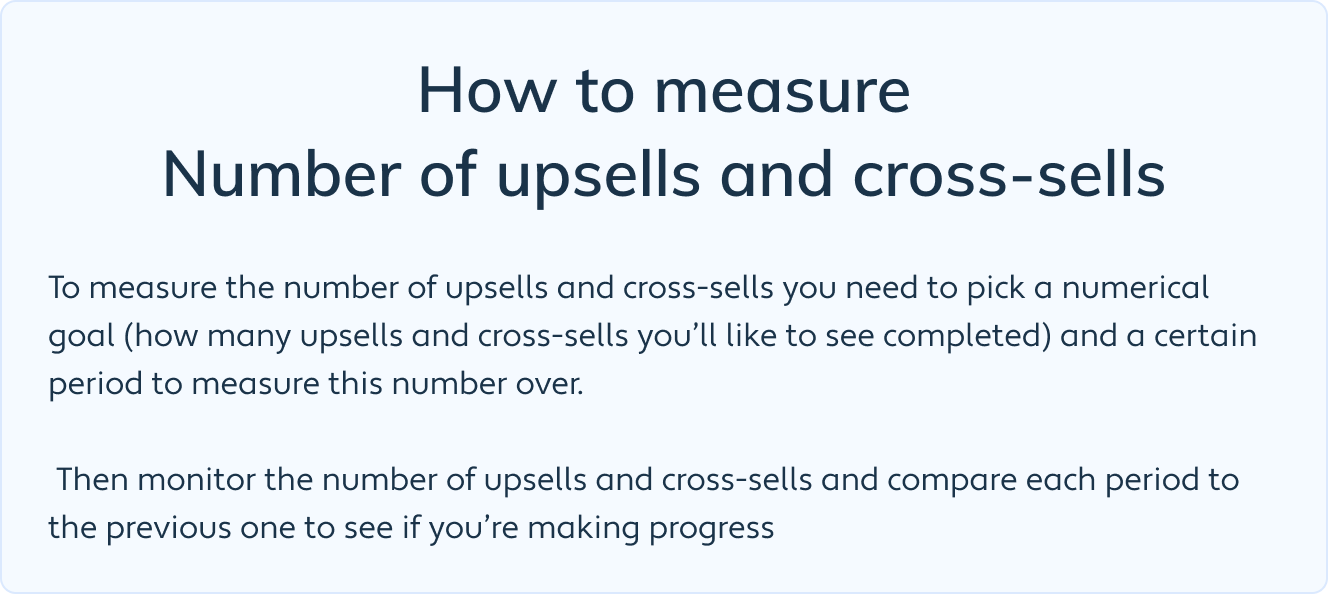
Active Issues
This one is pretty straightforward. All this customer service KPI depicts is how many active issues your customer service reps have to deal with. Or, to be more precise, how many customer-reported issues your whole company is dealing with.
While this might seem like a “too simple” KPI to be even measured it’s a basis for any further optimization.
By knowing the exact volume of active issues that you have to deal with per day, week, and month you’ll be able to make predictions and optimize the resource you use.
Plus, by measuring over a long period, you’ll be able to spot certain trends and get ready for these overdemanding times.
Besides that, knowing the exact number of active issues will help you distribute them more evenly between your reps and make the workload more manageable.
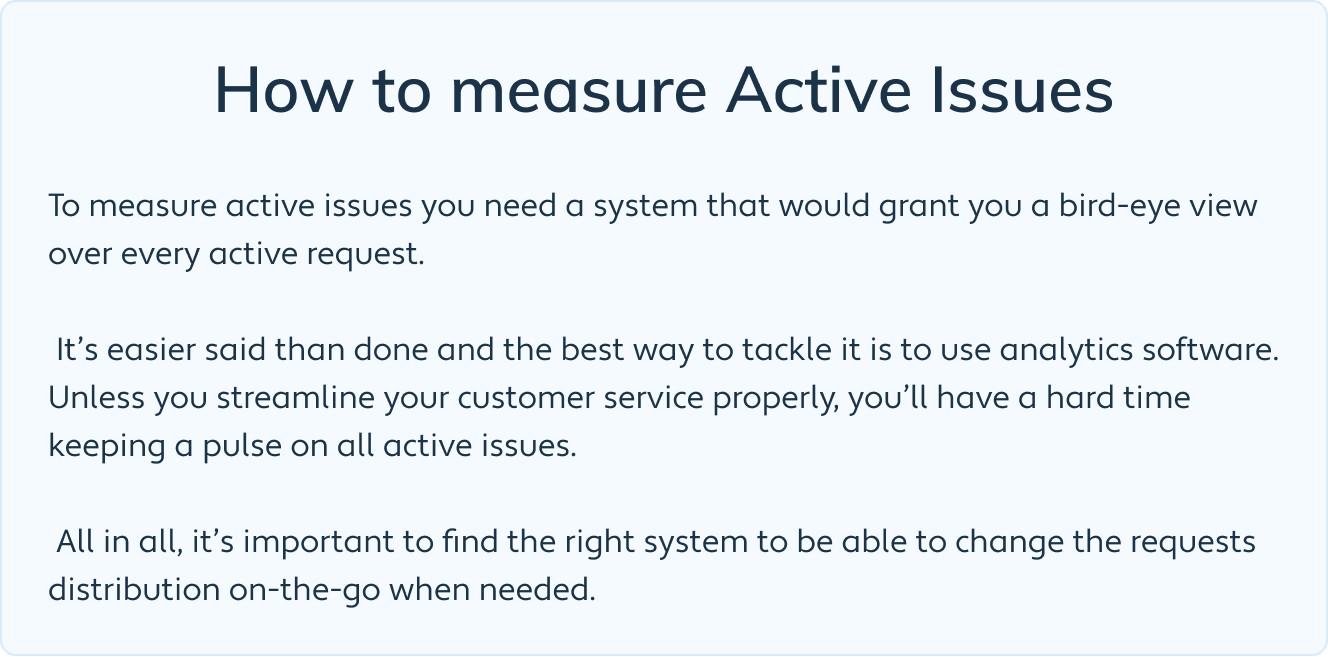
Resolved Issues
Resolved issues is another straightforward customer service KPI that can help you optimize the workload distribution and spot your customer service weak points.
By knowing who deals with the exact number of customer issues, you may distribute them more evenly by making changes to who works where, as well as, by changing the way you distribute calls, tickets, email, etc.
Also, analyzing the number of resolved issues over a certain period of time may reveal that some reps are lacking skills.
In such cases, it’d be wise to cut them some slack and allocate a percentage of their time for training.
By monitoring this rather simple customer service KPIs you may find out underlying weaknesses and things that are easy to improve but you may have not seen them before as you weren’t monitoring them at all.
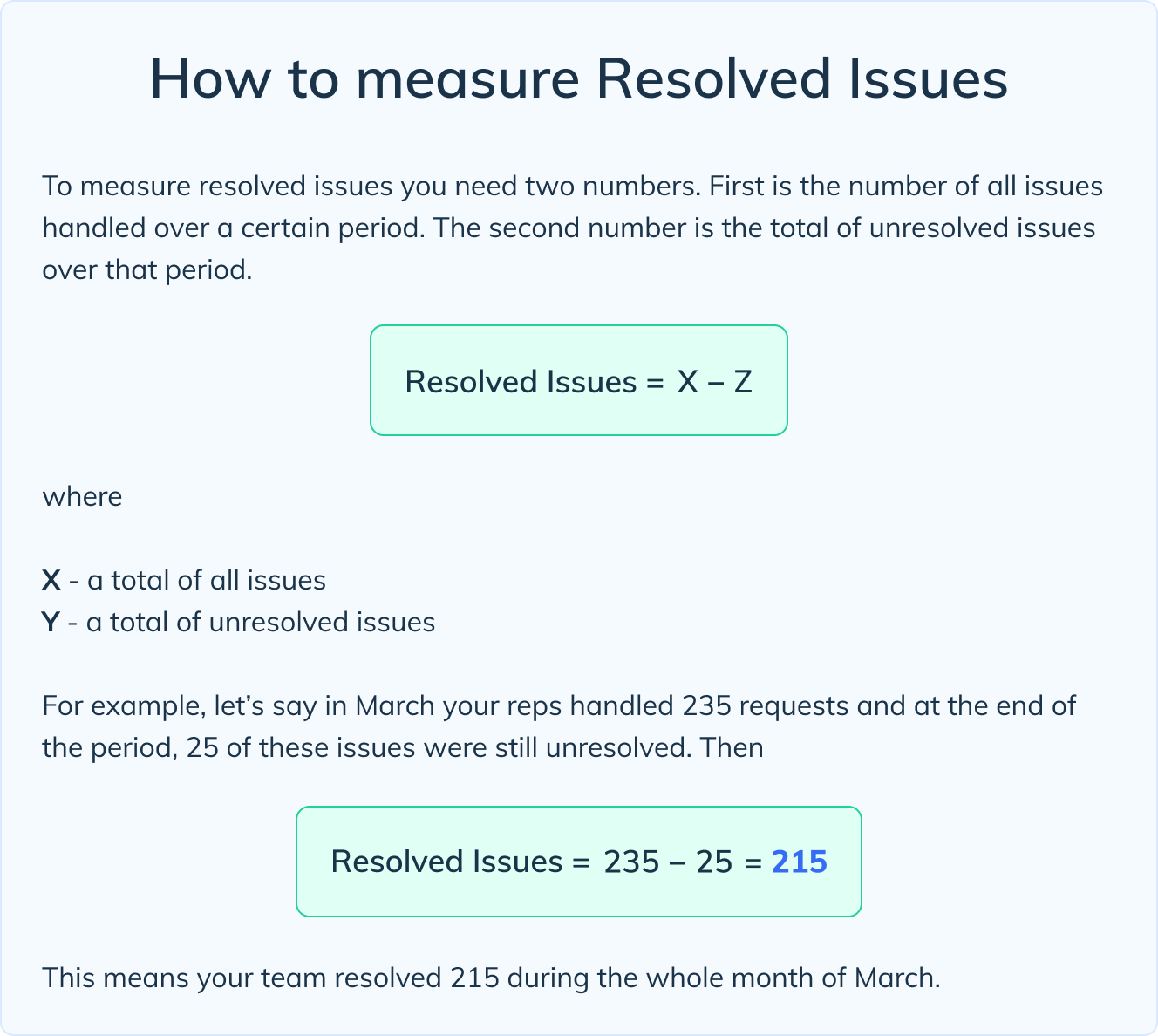
Escalation Rate
That’s a very interesting customer service KPI that not many managers and businesses measure.
What it indicates is the number of customer service requests that go beyond the first line of support. Meaning that your customer service reps weren’t able to resolve the issue and had to pass it further, e.g. to the development team.
This correlates with the FCR metrics as anything that isn’t FCR has to go deeper into the company to get resolved.
There is no industry-standard threshold but, in general, you want to keep this number as low as possible. If the escalation rate grows too big it means that your product is way too complex or way too faulty.
Of course, each product or service has its weaknesses but if let’s say 80% of issues can’t be resolved on the first line then your customer service becomes the connector between customers and developers and your development team should be renamed to the maintenance team.
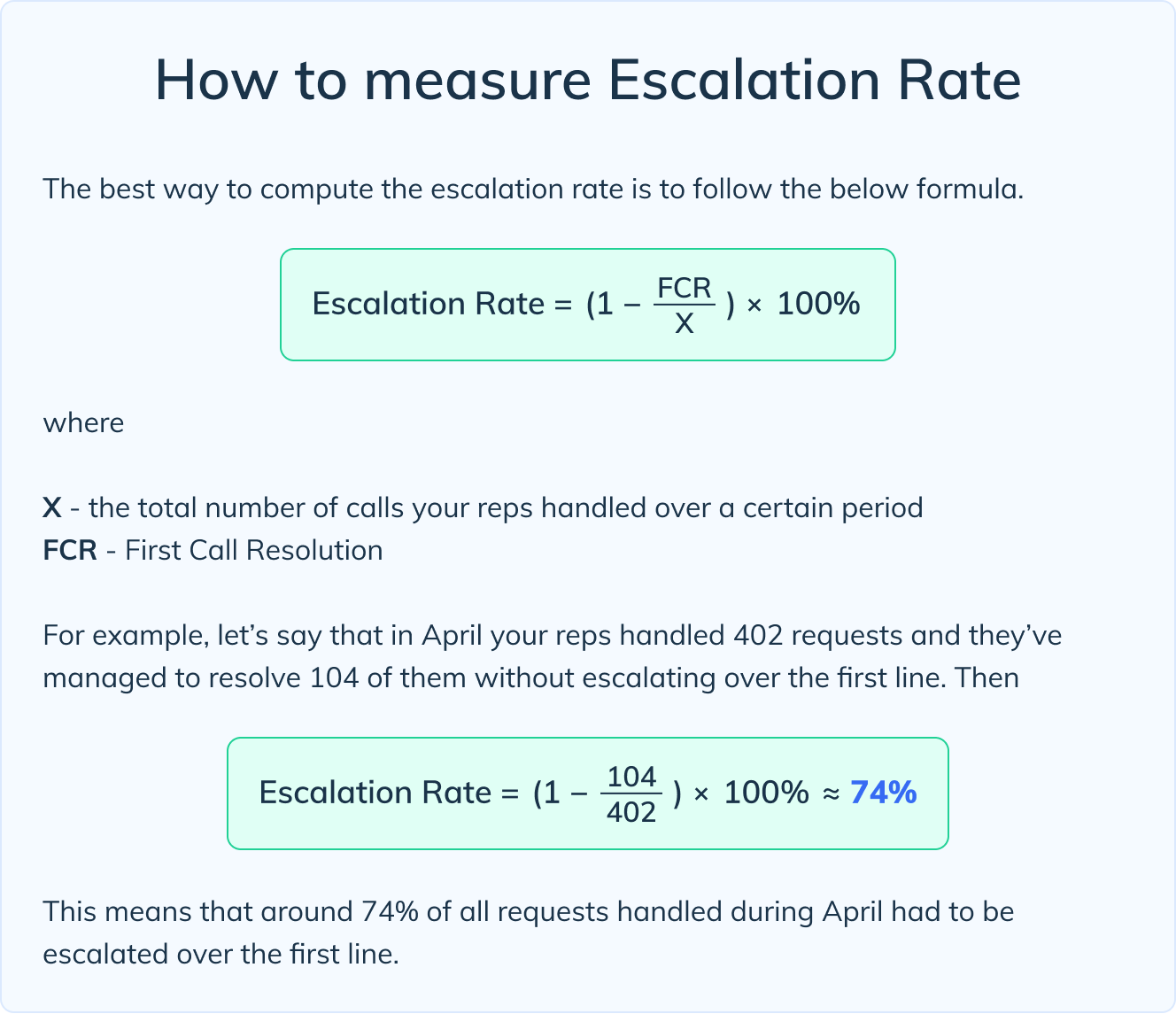
Customer wait time
Did I mention that speed is one of the main customer service principles?
Well, nothing is further away from thinking about the speed than the time spent waiting.
Customers hate when they’re put on hold or being redirected. If it takes longer than a minute to connect to the representatives most of the customers will end the call right there.
Again, no industry standard, but everything in less than a minute gets an A.
This customer service KPI correlates with the number of active issues. It may be simply too much to handle for your reps and all you should do is work on the distribution of the workforce among your team.
Another way to deal with that is to set up some filtration systems like IVR. Then when the customer calls he will be greeted with a welcoming message and will choose the reason for his call.
This way he won’t have to unnecessarily wait to get connected and it will limit the number of redirects or times when your reps have to put him on hold.
Set up your own IVR
Using Channels it takes less than 3 minutes to set up your own IVR.
Cut the customer wait time to seconds and offer service that will keep your customers coming for more!
7 days free.
No limitations.
No credit card is required.
Everyone hates waiting so make sure your customers don’t ever have to feel that way.
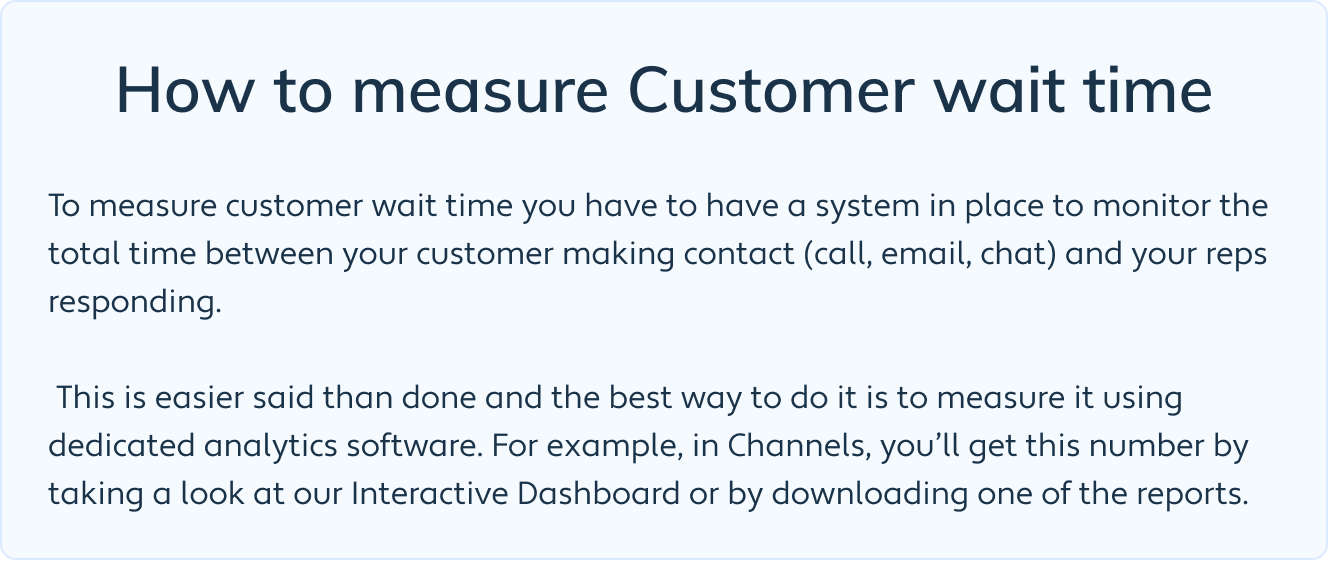
Product/service knowledge
Crucial customer service KPI for any business that treats their customers the way they should be treated.
Too often we encounter customer service reps that are only able to copy-paste FAQ articles or to set up a ticket that will be further resolved by more skilled employees.
As Shep Hykes says “Your customers no longer compare you to your competitor. They compare you to the best service they ever had… from anyone.”
If all your customers get on the first line is undercover “I don’t know” they’ll likely go search for a similar product with better customer service.
And, this KPI is not to reveal poor skills but rather the lack of training among your customer service team.
To find out whether their product/service knowledge is on the appropriate level, construct a survey that will test their skills. Use hypothetical conversations or, even better, past issues that your company had to deal with.
Then, devote some time to training those who lack essential knowledge.
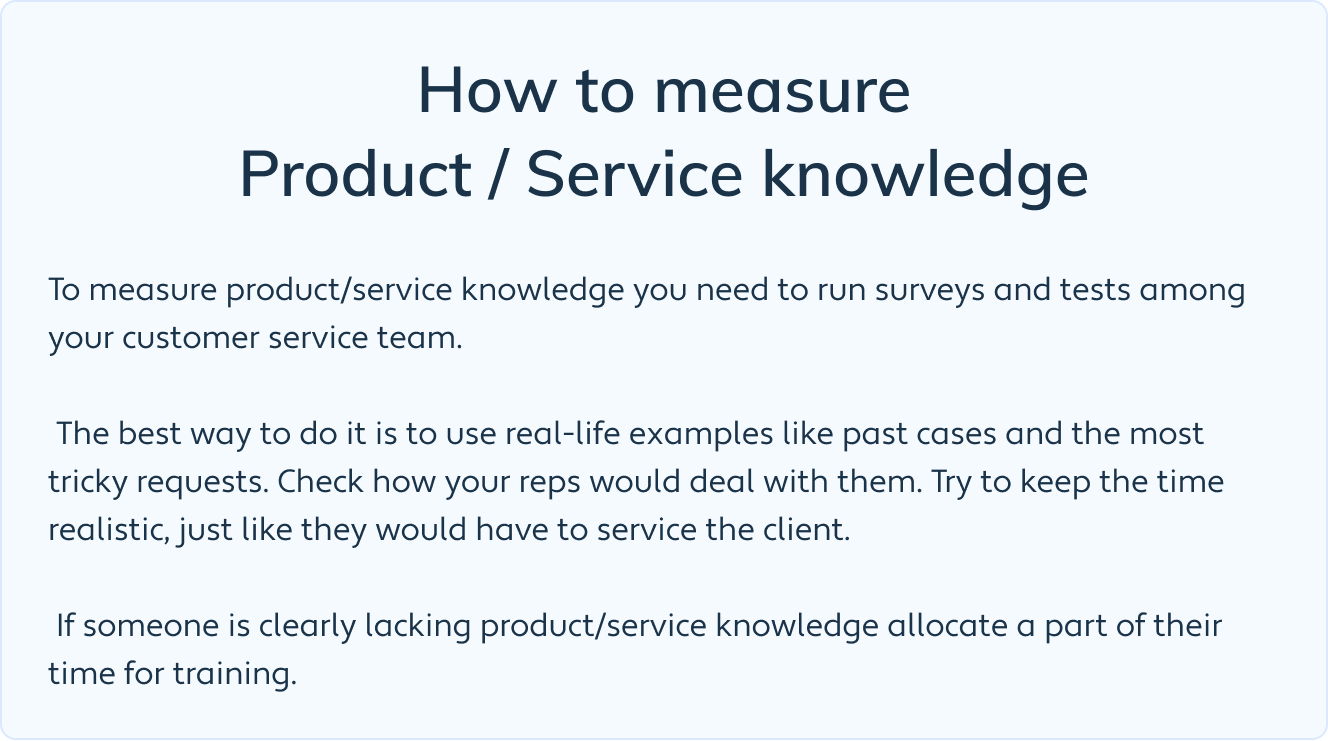
Customer handover rate
We’ve talked about it indirectly throughout this piece.
Customer handover rate is the number of times per all the first-time issues that your reps have to redirect the call, email, or chat to another representative.
This may take place because a certain rep is not skilled enough to deal with this issue or that there’s no proper call distribution system and reps who’re not meant to answer certain calls still get connected with such customers.
If it’s the prior, customer serving training is the answer.
If the issue is no proper system then you should check out tools such as Channels and the built-in IVR which will help you distribute calls depending on customers’ issues. This way you’ll always connect customers with the right reps lowering down this rate to 0.
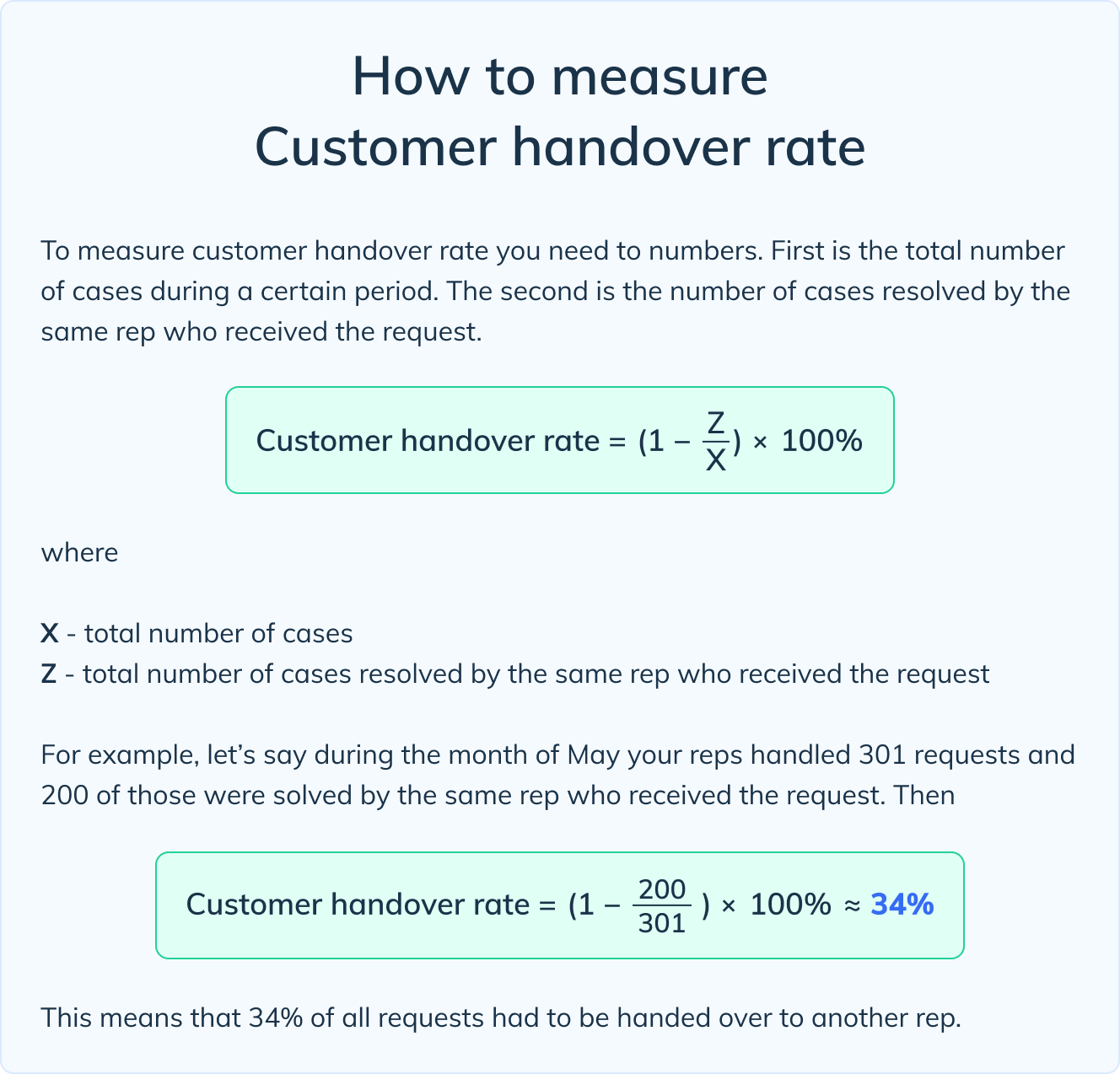
Minutes spent on call
This customer service KPI touches another aspect of speed and that is the average duration of calls. That’s how we make a full circle to the customer service principle of speed.
It’s good if you always answer your customers’ calls. It’s good when all it takes to resolve the issue is that one call. But it all won’t matter if you have to spend half an hour with that customer talking.
Measure minutes spent on call and analyze it so, if it’s necessary, you can implement a certain framework that will help you or rather your reps go from explanation to the resolution much quicker.
Sometimes it might be hard to explain certain issues. This can be solved by implementing various methods of contact.
For example, Channels integrates with LiveChat so you can hop on the phone when the issue is too complex to deal with it over the chat.
Another way to tackle such an issue is to utilize tools such as Loom. Your customers could make a simple screen recording to explain the issue and, if necessary, you’d be able to send such a video to your development team.
All in all, make sure your reps and customers don’t have to spend too much time on the phone.
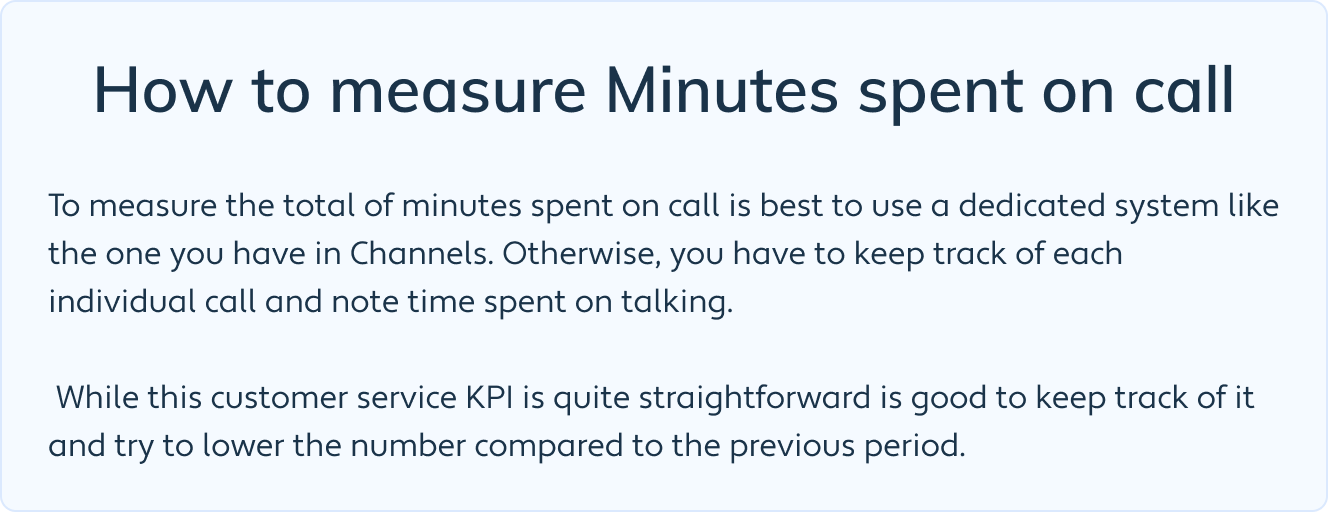
Customer complaints per call
This customer service KPI may help you find reps who are underperforming on purpose. While we all know this is rather an odd scenario it may still happen.
In general, customers should have no reason to complain about your reps’ work. In fact, oftentimes it is an angry customer who starts to attack your rep. Of course, in such a case this shouldn’t be treated as a complaint and rather as a rude customer with who you shouldn’t be doing business.
To spot complaints, randomly go through call recordings or analyze the work of the reps who’re getting red flags often.
Hopefully, you won’t find this customer service KPI useful and no changes will be made after reviewing it 😉.
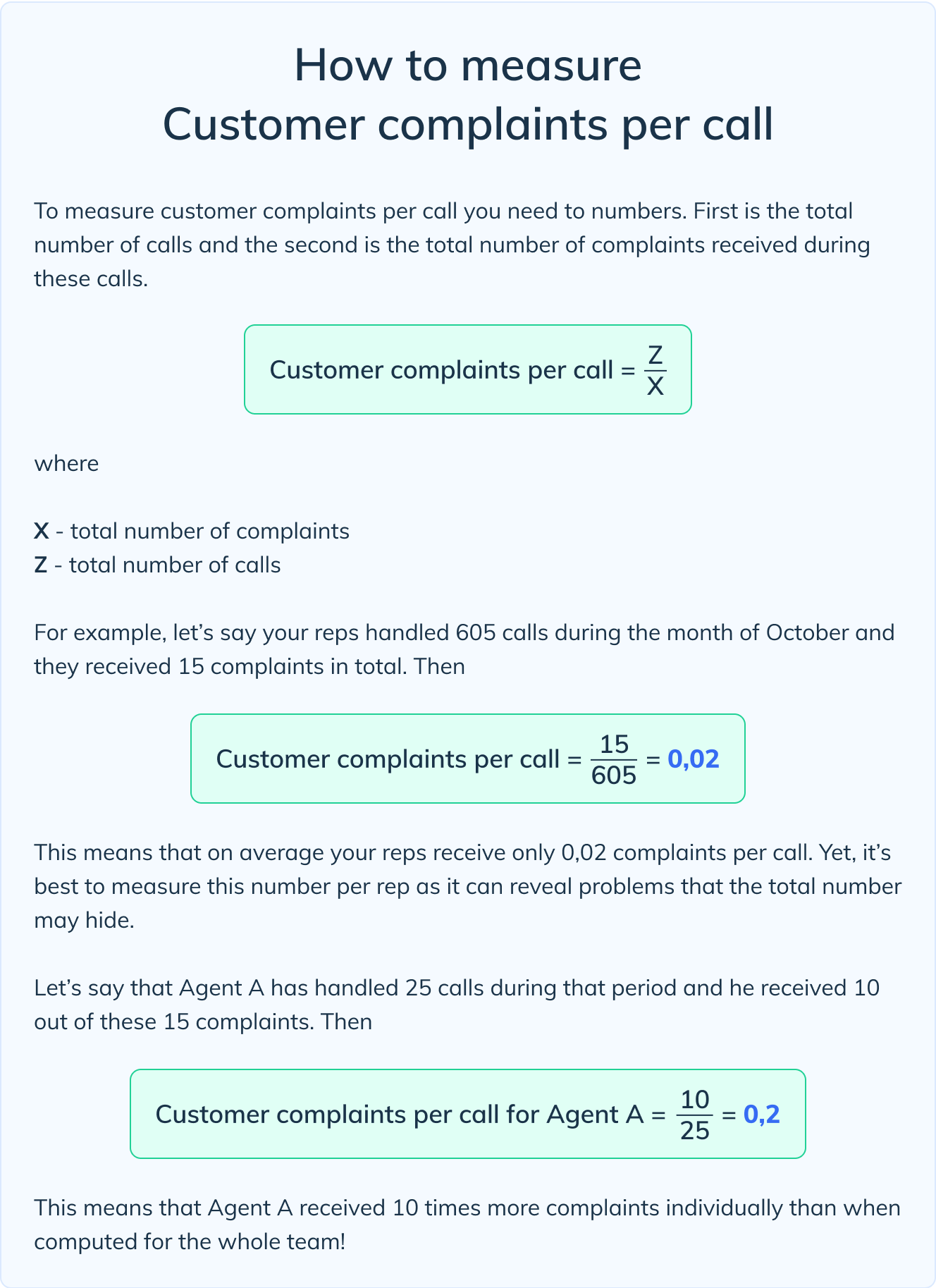
Number of callers abandoning calls
This customer service KPI is tied to the customer wait time.
Naturally, the longer your customers have to wait until you answer their call, email, or chat the higher the chance they’ll abandon it.
Unfortunately, even one such poor customer experience can lead to a lost customer who’ll spread the bad PR for you.
If abandoned calls are a common issue inside your company it should be your priority to crush this number to 0. A healthy customer service team should be able to answer all the calls in a reasonable time so no customer has to put the phone down.
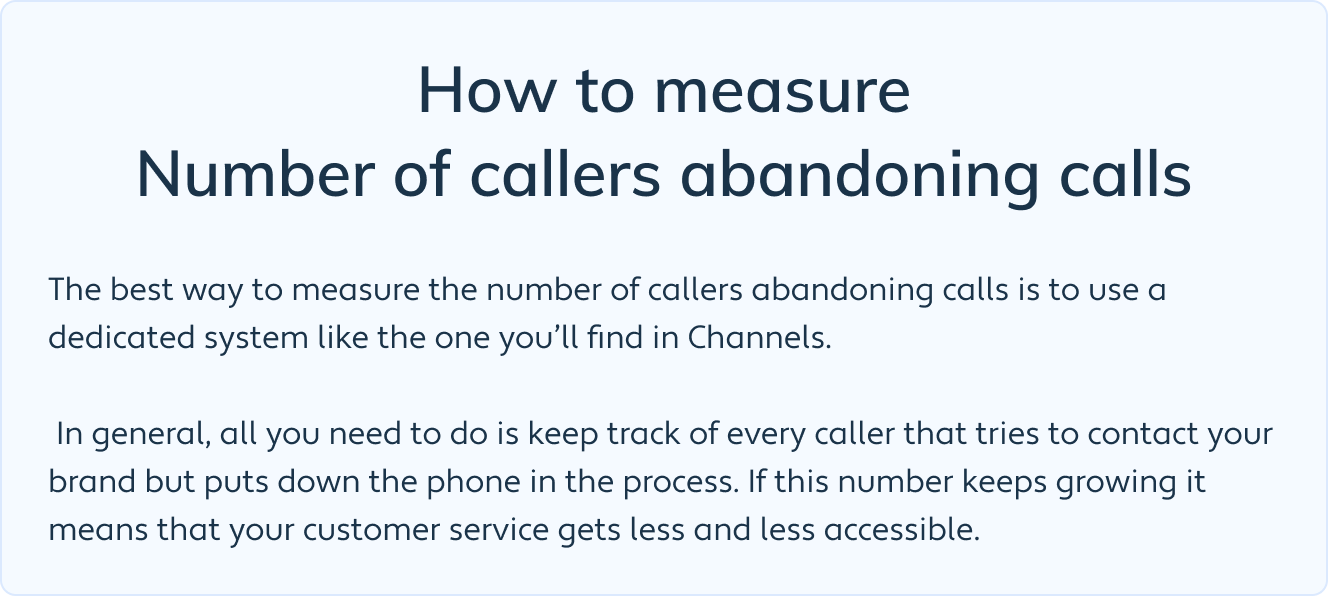
Replies per resolution
Replies per resolution customer service KPI depicts how many times the rep and customer go back and forth before coming to a resolution.
This metric may reveal an underlying complexity of your product or service that requires so much internal communication that the replies between rep and customer get choppy and happen too often.
Monitoring this customer service KPI will help you spot such issues that could be caused by the newest updates or changes to your product.
Here, as in many cases, the lower the number the better!
Which customer service KPI is your favorite?
We’ve made it to the end of the list!
Do you have your own favorite customer service KPI that, as you think, is the most important metric to get it all right?
For some, it is CSAT, for others CES or even FTR.
Let us know and see you in the next article! 👋



